Random Reviews: Savage Dragon: Baptism of Fire (The Image Review-lution, Part 3)
While occasionally too quick and shallow, Erik Larsen's Savage Dragon starts off more competently than his fellow Image Comics compatriots
—by Nathan on October 30, 2023—
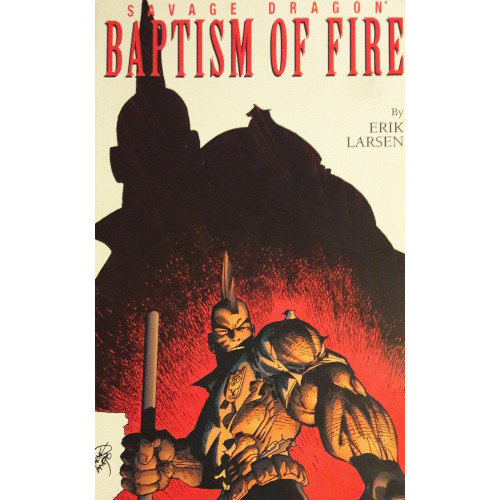
I have, the last few weeks, been duly critical (from a purely subjective standpoint, naturally) of the two initial series published by Image Comics, Rob Liefeld’s Youngblood and Todd McFarlane’s Spawn. Despite Image’s passionate gamble in leading the charge for creator-owned comics during the early 90s, both books stumble at the start, sidelining unique characters and well-written stories for pouches, big guns, pouches, over-the-top violence, pouches, and a whole lotta surface level tension. It’s a testament to the creative cults each of Image’s founding members had established through their prior work (primarily Liefeld, McFarlane, and Jim Lee) that the company maneuvered through this rocky start to become a powerhouse in the field. Without these first desperate clutches at creative freedom, there would be no Invincible, no Saga, no Walking Dead.
Over the last year or so, I’ve packed a little Erik Larsen experience under my belt. I was largely won over by his depiction of the Sinister Six, hailing his takeover of Marvel’s "adjectiveless" Spider-Man title from McFarlane as largely a success. I’ve enjoyed his art in some other arcs I’ve read. Primarily for that reason, I entered his contribution to the mounting Image pantheon, Savage Dragon, a little more hopeful. Not that the bar would be high to surpass, but I wanted to know if the lean, green fighting machine competed well against the devil’s spawn and the new blood of costumed superhero-dom.
Bit of a spoiler, but…yeah. He kinda does.
Savage Dragon: Baptism of Fire
Writer: Erik Larsen
Penciler: Erik Larsen
Inker: Erik Larsen
Colorists: Gregory Wright, Steve Oliff, Reuben Rude
Letterer: Chris Eliopoulos
Issues Collected: Savage Dragon (miniseries) #1-3
Volume Publication Date: February 2002
Issue Publication Dates: July 1992, October 1992, December 1992
Publisher: Image Comics
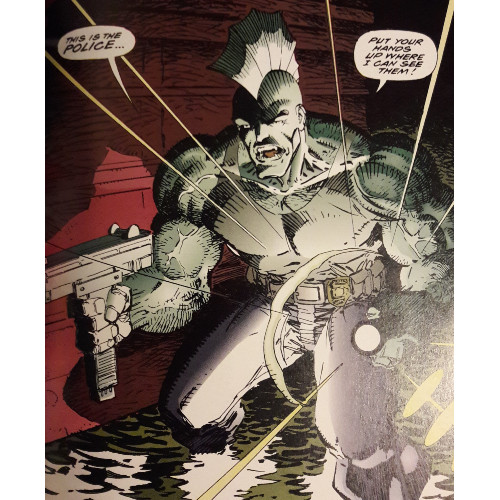
We like our green monsters, don’t we? They grace the sides of corn cans, smash their way monosyllabic-ally through the Marvel Universe, groan and bumble through old castles, arms stiffly extended in front of them. Heck, some of us may even love to hate the green monsters that throw pumpkin bombs at superheroes or blondes off bridges. A monster is frightening, hideous (most of the time), strong, sometimes illogical or prone to violent rampages. And yet, as proven by guys like the Thing and the Hulk, just because you stand head-and-shoulders above everyone else and can toss a tanker truck with one hand, it doesn’t mean the general populace should cower before you, right?
That seems to be what the Savage Dragon wants to prove. And that’s how Larsen sets his creation apart from the last two Image Comics series I reviewed and possibly the others I haven’t yet discussed.
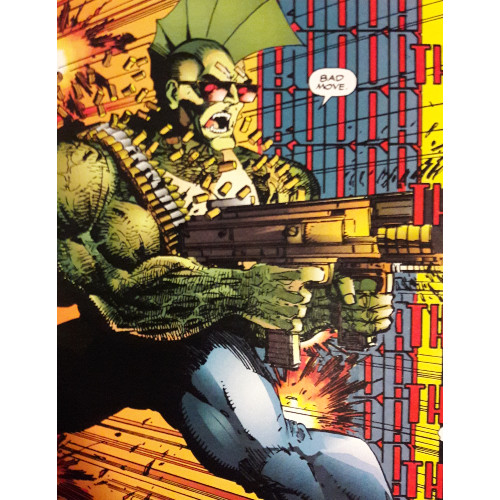
As I noted in the introduction, I entered McFarlane’s initial Spawn issues with some baggage from my opinion on his other narratives. I beheld Savage Dragon with fewer qualms, approaching the series a less critical eye. I was already more impressed with Larsen’s work on Spider-Man than McFarlane’s, so I was predisposed to hoping this lethal lizard would stand above his peers even before I cracked the spine of the volume containing the character’s inaugural limited series. That may be an unfair assessment to some, and as much as I want to begin these narratives with a blank slate, it’s hard not to apply some preconceived notions. I’m going to read a story by Alan Moore or J.M. DeMatteis more confidently than a story by, for example, Rob Liefeld or Howard Mackie (particularly "Clone Saga era" Howard Mackie). DeMatteis has a track record of crafting strong stories I’ve enjoyed; Mackie, not so much. Same with Larsen, even if my general exposure has been through his art.
The Dragon’s debut isn’t perfect, mind. The concept is engaging–waking up in a hospital, our green protagonist can’t remember anything, an amnesiac like Jason Bourne. All he knows is he’s green and sports a big fin atop his head. Larsen establishes this central concept quickly…a word which defines a good chunk of this volume. Quick. In just three issues, the Dragon very speedily integrates himself into a Chicago police department with the help of a kind cop, battles a variety of rogues, meets and loses a girlfriend, and descends into a deep depression Larsen basically glosses over until the final page. So much is packed into just three issues that by time you reach the last page, you feel you’ve read a series double its length. It’s a complete story, and though I appreciate Larsen not leaving us on a cliffhanger (which is simply a personal preference cause I don’t intend on diving into the Dragon’s long-running main series), I felt I waded through the bulk of the volume rather than dove deep.
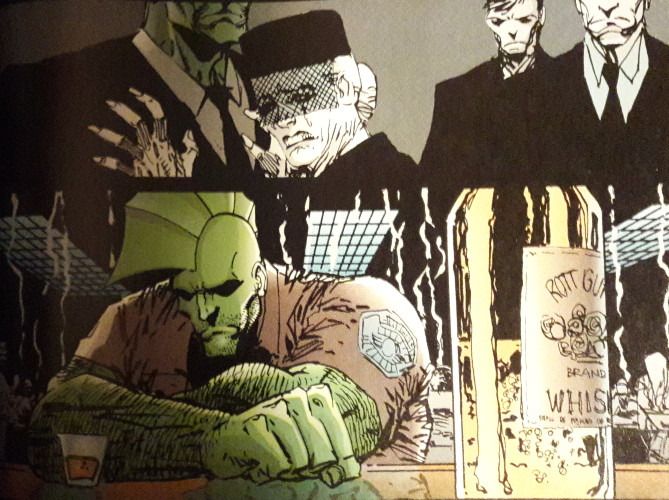
But if we look at individual components, analyze them beyond their narrative briefness, we find a series that at least had more thought poured into it by its creator. There’s structure here that Liefeld’s Youngblood lacks, an intentionality in driving the story forward and developing its main character even at a rapid fire clip.
From the start, Savage Dragon is cast in the mold of a sympathetic character–we understand his frustrations as this wandering soul, his memory gone, with no knowledge of who he is. We watch his introduction to the Chicago police force as a fulfillment of much-needed purpose, even as he faces some opposition from within (a bit more on that later). And as much as the pacing feels wonky at times, Larsen wisely allows the Dragon a few moments to himself, where the "camera" lingers. After a tragic warehouse explosion, the Dragon kneels in the flames, awash in both fire and failure. Larsen delivers some other wordless sequences, letting the reader draw in and interpret the emotions.
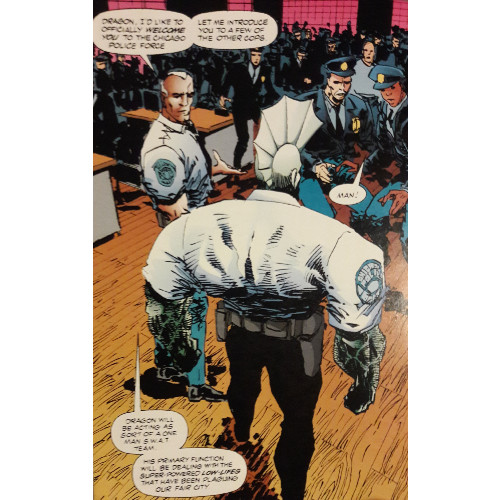
Amusingly–and I can’t say I expected this–Savage Dragon takes on this critical eye towards the trends of the 90s. Yeah, there’s a whole lotta punching and wreckage, but Larsen has fun commenting on the goofy excesses of the era, which his Image compatriots were responsible for promoting in their own books. A scene where the Dragon grabs multiple guns for a mission feels less akin to McFarlane strapping guns galore to Spawn’s back, simply done for the "cool factor." Larsen visually pulls off the scene well, but the Dragon ends up utilizing his weaponry, calling to mind a scene from Frank Miller’s The Dark Knight Returns where Batman corners a hostage taker. The violence seems placed more organically, more natural to the vibe Larsen is creating. The Dragon not only looks radical, dude, but the excessive weaponry plays a role which ends up making sense for the story.
Elsewhere, the Dragon fights and defeats Youngblood member Bedrock in a pitched battle, and though this allows for some cross-promotion between these burgeoning Image Comics series, it’s also a very clear message: in an industry where stalemates often occur between skirmishing heroes because fans can’t see their favorite guy lose, we’ve got a clear victor in this battle. The Dragon’s decisive victory over Liefeld’s creation can certainly be seen as some nose-thumbing on Larsen’s part ("my guy can beat up your guy"), but it’s also a small testament to how Image is trying to make itself unique. Heroes can lose. Your favorite big brawler can be beaten by someone else’s favorite big brawler. And, narratively, how better can you establish the strength and durability of your own creation than by having him take down the powerhouse member of someone else’s team?

While all this goes on, Larsen strives to incorporate a strand of social commentary not necessarily seen in either Youngblood or Spawn…or, if it exists, not used as effectively. To the common man, the Dragon represents a world drifting towards the spectacular. He finds himself at odds with some fellow police officers who are afraid of "workin' with freaks." Despite his insistence he’s no different than other folks, just green (calling to mind a subtly inserted racial undertone established by Larsen through the miniseries), the Dragon becomes a controversial figure. Some grow to love him, others distrust him. None of this alters our perception of who the Dragon is–even if we don’t have a name or a backstory for the guy, we’ve already come to trust him pretty quickly, and Larsen doesn’t suggest we need to begin looking at him askance. We’re more interested in his budding relationship with a community not certain of who he is…or, more importantly, what he represents. Youngblood has its celebrities, and Spawn slinks in the shadows, relying more on Batman-esque fear. The Dragon needs to build clout, show that under his verdant skin exists a heart towards humanity.
As noted, the miniseries ends as it began, pumping the brakes a tad too much and skidding to a somewhat sudden stop rather than allowing for a smooth finale. Some of this herky-jerky movement may be because the Dragon received his own ongoing series, meaning that while Larsen has introduced the character well, there’s nothing he can really tie-up in any seriously satisfying manner. We’re given, again, a few static images which nicely represent a shift in the Dragon’s attitude and personality, but these come in at a lightning pace. Knowing there are issues I won’t be reading, it is a tad difficult to fault for Larsen bringing the plane in turbulently. It’d be like only reading Amazing Fantasy #15 and complaining Lee and Ditko leave Peter Parker in an unsatisfactory situation. "His uncle’s dead, barely avenged, and you’re just gonna leave us?" you grumble, totally ignoring the next 60 years of content. I know I’ve brought this on myself by setting aside the Dragon’s subsequent adventures. But, in my own defense, Larsen tosses in a fairly significant plot development and allows for three silent panels to paddle through the ramifications before leaving us in a patch of darkness shortly before the final page. It’s very sudden, very fast paced.
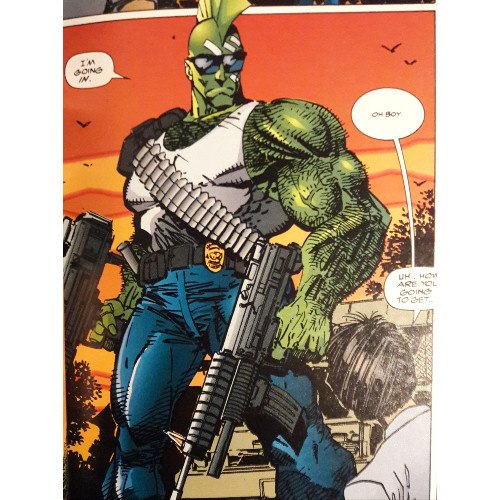
So, like some of his Image Comics compatriots, Larsen’s Savage Dragon isn’t a perfectly started series. But its voice is distinct and unique, less prone to the overwhelming number of underwhelming moments riddling Youngblood and Spawn. Guided by a unique premise, intriguing hero, and a more deft, somewhat self-referential sense of the issues plaguing other titles, Savage Dragon gets a lot right. Yeah, it has its characteristic troubles, but I fully admit to shooting myself in the foot by ignoring additional installments. I don’t know if I’ll go to the effort of following the Dragon’s fiery trail, but it would take a lot less to convince me to read more of Larsen’s saga than it would McFarlane’s or Liefeld’s.